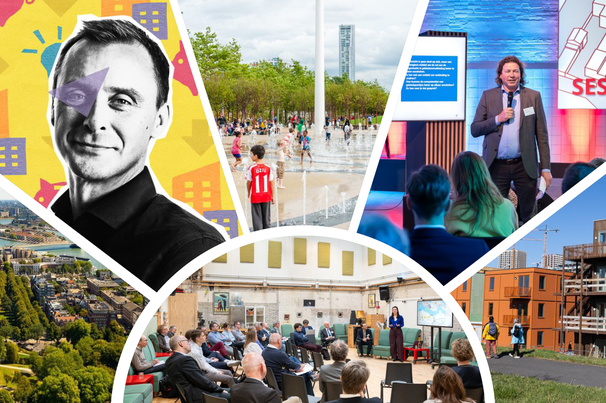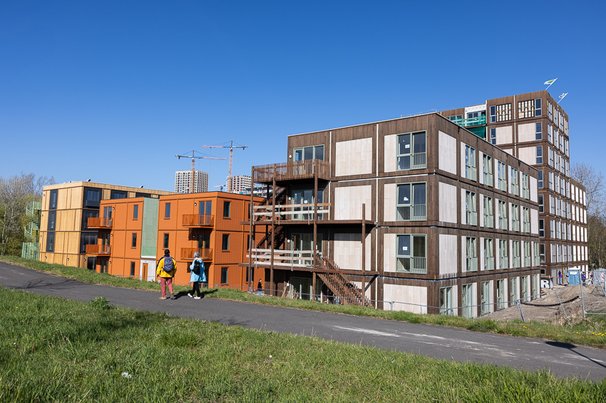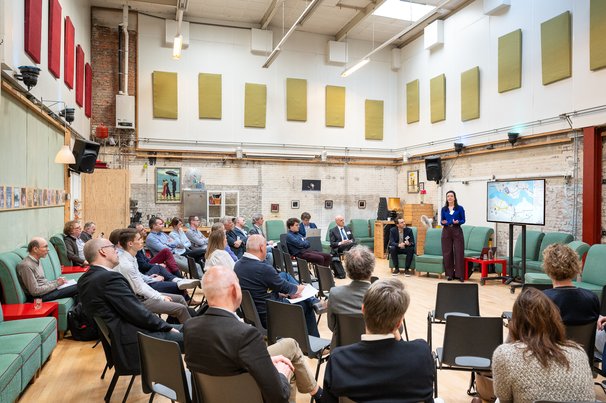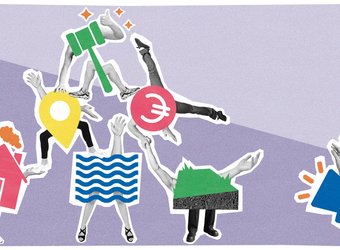Casus Quality in town and country planning, water safety and integrality are the core objectives in the WaalWeelde programme, an area development project along the river Waal. The Waal is the main distributary branch of the river Rhine flowing through the Netherlands. It is the major waterway connecting the port of Rotterdam to Germany and the busiest river in Europe. In 2006 a start-up group set out to keep the river and its banks liveable and beautiful. This initiative has now grown into a wide network of cooperation. The Province of Gelderland is the public developer and manager. Fundamental to the approach of this project is connecting what needs to be done with the various interests involved, on the basis of a vision that widespread cooperation will lead to increased quality and public support.
WaalWeelde connects necessary works with other interests
Practical lessons
- Clustering national and provincial government budgets and allowing the province to manage this. Programme monies from the national government are then targeted specifically to, for example, water safety interventions, rather than general projects.
- All parties (executives, civil servants, businesses, local residents and interest groups) are actively involved in the early stages of planning and decision-making in order to achieve quality and public support.

Area of the WaalWeelde project: beyond the dikes of the river and the Upper Rhine, from the German border to the South Holland provincial border. The Waal area includes 13,500 hectares of floodplains along 80 km, with a total population of 500,000. Main cities in the area are Nijmegen, Tiel and Zaltbommel, which have direct access to the river. Source: http://www.waalweelde.nl
‘Waal River: widespread cooperation - Afbeelding 2’
River-broadening measures
The WaalWeelde project was formulated to address the need for a broader river to ensure water safety for the region, as described in the national planning policy Room for the River (2007). This document proposes various spatial expansion measures to make the Dutch river regions (which flooded in 1993 and 1995) safer and more attractive. The Waal River requires several interventions to be executed by 2015. Among them are groyne reductions (to prevent impoundment during high tides) and localised repositioning of dikes.
Apart from water safety issues, all sorts of interests are involved, such as nature conservation, economics, recreation/tourism, heritage, sustainable energy and climate change issues. The great diversity of uses along the Waal River is an attribute, but also requires measures to prevent spatial cluttering or fragmentation. Improving the general spatial quality of the Waal landscape is therefore the overriding goal of the WaalWeelde programme.
Over time, an extensive parkland landscape will be created by the addition of natural and monumental elements. The Province of Gelderland expects that the operation and end results of a broader river will generate local investment opportunities, for example in the area of recreation and tourism. To this end, the project ‘Experience the Waal’ was instigated.
Local parties have already initiated dozens of projects, reinforcing the bottom-up approach. It is however impossible to implement all the projects at the same time with the available capacity, means and support. The most promising projects – those in the design stage, with a clear initiator, with local support and that have sound financing – have been inventoried. Also by working together with the national Delta Programme projects that contribute to long-term water safety goals (e.g. water capacity of 18,000 m3/s near Lobith) have been inventoried.
Case Study: Nijmegen embraces the Waal
Some projects along the Waal are already being executed. One of the most complex projects arising from the Room for the River policy is pushing back the dike at Nijmegen. The Waal waters will gain more room to manoeuvre by repositioning the dike some 350 meters inland. A secondary channel will be excavated in the newly opened space. This will create an island in the Waal that has rich potential for recreational and residential use (see artist’s impression at the beginning). Work on this has already started. See also: Nijmegen embraces the Waal.
Spatial Structure Vision
A is currently being made for the western end of the Waal. Its sights are also set on 2015 and aligns with the national Delta Programme. Initial analyses show that along this section of the river significant interventions are needed to ensure water safety for the future. The province and municipalities involved have published the various options outlined in the Structure Vision online, and invited residents and other interest groups through information evenings to respond to the proposals.
Far-reaching cooperation
At the centre of the programme organisation for WaalWeelde is a Management Platform together with its civil servant teams. This is where decisions are prepared and made regarding, for example, finances and spatial programming. The Management Platform (which includes the 15 councillors responsible for urban planning in their municipality) also exchange information and knowledge gained from running or planned developments. A Reflection Group, comprised of businesses, citizens and interest groups, monitors the cooperation between the four partners (businesses, interest groups, civil servants and executives) and reflects on management decisions. The Reflection Group participates in the thinking process, acts as a sounding board and signals discrepancies between management intentions and implementations. The backbone of the management board is the provincial authority’s programme team, under the leadership of a Programme Manager.
The Province of Gelderland is responsible for connecting parties with each other and takes care to address any complications along the way. The province and the Ministry of Infrastructure and Environment are both investing 30 million euros in the WaalWeelde programme, as a result of new agreements regarding shared financing of promising projects. National and provincial government budgets are being clustered (both are cracking open their safes) while the province manages the projects. Finances from national coffers are then allocated for a specific purpose (or indeed programme) rather than given, in the traditional way, to an entire project without definition as to how it is spent.
main ecological course
Cooperation in the realisation of projects has been placed within a broader network of public authorities, all involved in some way with the river (the Delta Programme, municipalities, the National Water Board, the Countryside Agency, State Forestry and the Rivierenland Water Board). In particular, the cooperation on the works affecting the through the province have been given priority within the WaalWeelde programme for the immediate future.
Recently property ownership has also become a subject of cooperative analysis. The WaalWeelde project initiated setting up a strategy, in cooperation with the national Real Estate and Development Agency, to optimise the use of properties owned by the different public authorities. This makes optimal use of the limited overall means (money and property).
Programme facts
Size
Area beyond dikes along a stretch of 80 km.
Type of development
Increasing water safety and quality of environment surrounding the river.
Cooperation
The 15 riverside municipalities, the Rivierenland Water Board, the National Water Board, the Countryside Agency, the Ministries of Economic Affairs and of Infrastructure and Environment, interest groups, businesses, local residents, all under the direction of the Province of Gelderland.
Financing
Approximately €500 million euros from the Room for the River budget is being invested in measures to provide the river Waal more room to manoeuver, in particular the broadening of the river and relocation of the dike at Nijmegen. The national government will continue to invest through the Delta Programme in the following decades.
The Province of Gelderland and Ministry Infrastructure and Environment are both investing 30 million euros in the first set of promising area projects. Renewed spatial planning of the floodplains Hurwenen and Heeselt between Tiel and Zaltbommel are two projects that will be realised.
This text is based on content from
Vertaling: Dianna Beaufort
Cover: ‘2013.09.18_waalweelde_ENG_500’





